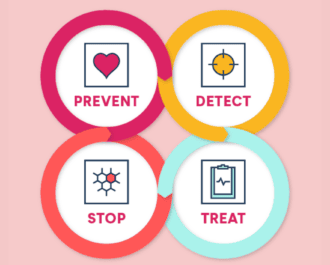
A simple blood test may be able to save lives by detecting cancers that have started to grow again after treatment.
Predicting whether a cancer patient will relapse remains a formidable challenge in modern medicine, but circulating tumour DNA (ctDNA) in the blood may give clues about cancer cells that can be left behind after treatment and form new tumours.
The scientists at the Institute of Cancer Research in London have developed a blood test that detects traces of returning breast cancer eight months before doctors would normally have noticed.
The study, published in Science Translation Medicine, was conducted in women with early-stage breast cancer who had all been treated with surgery and chemotherapy.
If parts of the tumour have already spread (metastasised) to another part of the body before chemo and surgery, or if the surgeon did not remove all of the cancer, the remaining cancerous cells can grow again.
The findings open a window of opportunity to treat patients earlier in order to prevent cancer metastasis and suggest that a non-invasive monitoring of cancer via a blood test may one day help identify cancer patients at high risk of recurrence, guiding targeted therapy tailored for those individuals.
The hope is that detection of recurring cancer earlier means treatments including chemotherapy can start sooner and improve the odds of survival.
There is more work to be done to understand the full potential of the finding and determine if it can be developed into a test that doctors could use routinely. However, the principle could potentially be applied to any cancer that has gone through initial treatment for which there is a risk of relapse in the future.
The Institute of Cancer Research UK conducted the study in conjunction with the Royal Marsden National Health Service Foundation Trust.
NBCF funds research projects which are also seeking non-invasive methods of testing for tumour DNA in the blood for earlier initial diagnosis and better breast cancer treatment outcomes:
Developing of point-of-care biosensors for detection of breast cancer relapse: Tumour growth is accompanied by the release of tumour DNA into the surrounding tissues and blood, which makes the ability to detect tumour DNA in blood a very attractive new avenue for breast cancer diagnostics.
Professor Kirill Alexandrov from the Institute for Molecular Biosciences aims to develop a simple diagnostic test that identifies tumour DNA in the patient’s blood. Conceptually, it’s similar to the test used for measuring the blood sugar in diabetic patients. The test is based on semiconductor-like proteins that could be engineered to selectively recognise the tumour DNA and pass the information to a detector connected to a smart phone. Such a test with immediately available results could dramatically improve the treatment outcome and quality of life of breast cancer patients.
Circulating tumour DNA as a personalised biomarker in breast cancer: The measurement of circulating tumour DNA (ctDNA) in the blood of women with breast cancer has the potential to be utilised as a personalised biomarker in the management of the disease.
Through recent advances in genomic technologies it is now possible to characterise specific DNA mutations in a patient’s tumour, design assays to identify these mutations, and then apply these assays to plasma to accurately measure the amount of ctDNA. The potential clinical applications of this new technology are far-reaching.
The project, spear-headed by Dr Sarah-Jane Dawson at the Peter MacCallum Cancer Centre, aims to utilise this technology to study how breast cancers evolve when they progress and become resistant to treatment. Furthermore, she will evaluate if ctDNA can be used as a form of ‘liquid biopsy’ to serially follow patients and individualise treatment decisions in breast cancer. Together, this research could contribute essential biological insights into the evolution of breast cancer during disease progression. It may also address an unmet clinical need, by providing the opportunity for personalised disease monitoring in breast cancer.
More News Articles
View all News


